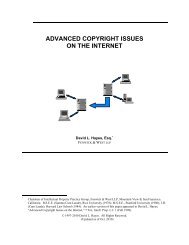International Tax Aspects of Foreign Currency Transactions
International Tax Aspects of Foreign Currency Transactions
International Tax Aspects of Foreign Currency Transactions
You also want an ePaper? Increase the reach of your titles
YUMPU automatically turns print PDFs into web optimized ePapers that Google loves.
5) Simply following GAAP may not be reasonable,because FAS 52 does not have a remittanceconcept.5. Special Considerations for Hyperinflationary Currencies.A. Definitions.(1) “Hyperinflationary” for tax purposes = Country’s consumer price indexshows a 100% cumulative increase over three years. 33(2) “Inflationary” as used for § 905(c) purposes = Country’s CPI increases bya cumulative 30% over three years. Note that “inflationary” taxes must betranslated at the date-<strong>of</strong>-payment spot rate under § 986.(3) DASTM = US Dollar Approximated Separate <strong>Transactions</strong> Method(DASTM) for translating results <strong>of</strong> a QBU operating in a hyperinflationarycurrency. Requires the branch to translate its balance sheet back into USdollars and include the translation adjustment as an adjustment to E&P.B. DASTM (§ 1.985-3).(1) Theory <strong>of</strong> DASTM. Pr<strong>of</strong>it and loss accounting <strong>of</strong> §§ 986 and 987 willcreate distortions in hyperinflationary environment. Entities with fixedcosts will earn excessive income as inflation increases gross receipts butnot historic costs recovered through COGS and depreciation. Interestbearing debt will also be distorted, as higher interest coupons <strong>of</strong>fset FXloss on principal.To prevent these distortions, DASTM requires a QBU to compute itsearnings in dollars. In addition, the QBU must compute a $USD net worthat the beginning and end <strong>of</strong> every period. The change in $USD net worthis DASTM gain / loss that is included in earnings and pr<strong>of</strong>its.(2) Pr<strong>of</strong>it and Loss translation (Reg. § 1.985-3(c)).(a)(b)Items are translated at the exchange rate for the translation periodto which they related. Translation period = any regular period <strong>of</strong> amonth or less that may be adopted by the taxpayer.Depreciation, inventory cost, and other historic cost items arereflected at the spot rate for the translation period in which theywere incurred.33Reg. § 1.985-1(c)(2)(ii)(D).44© 2013 William R. Skinner, Esq.Fenwick & West LLPwrskinner@fenwick.com
















